Jaeger-LeCoultre - the watchmaker's watchmakers signature - graces the dial of a chronograph ebauche, what an accolade! That's what makes these pieces for me so exciting. And as Universal Geneve is getting a modern reboot, interest on the history of the same-origin LeCoultre and Jaeger chronographs might increase as well. But as of today there still is a lack of scholarship. And a lack of scholarship inevitably leads to little interest in otherwise phenomenal pieces. Regarding vintage Universal Geneve - LeCoultre/Jaeger chronographs the challenges are multi-faceted: 1) vast number of references; 2) Rarity; 3) & White-Label production.
April 17, 2024
The Mystery Chronographs Part II - LeCoultre, Jaeger & Universal Geneve

Marcus Siems @siemswatches
Collector, Author, Data Analyst
Previously on LeCoultre & Jaeger chronographs ... Jaeger-LeCoultre - watchmaker os watchmakers - didn't actually produce any in-house wristwatch chronograph donning their own name until the mid 1990s[1]! However, in the meantime the Swiss watchmaker did launch a couple chronograph pieces with ebauche movements, either from Valjoux or Universal Geneve/Martel.
But the story isn't really that simple... During the 20th Century Jaeger-LeCoultre split its operation into three relatively distinct branches: Jaeger, LeCoultre & Jaeger-LeCoultre for the French, U.S. American and European market, respectively.
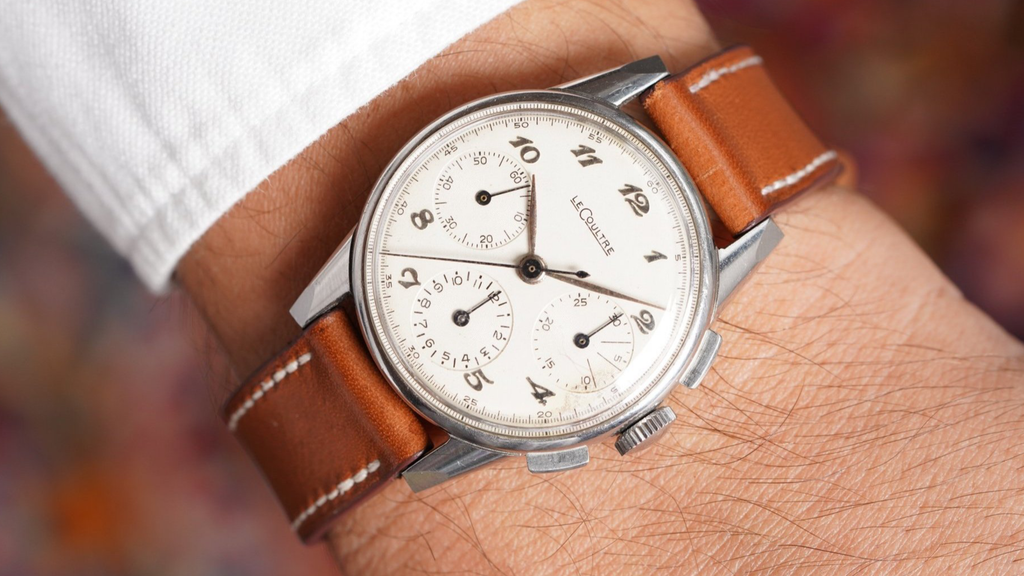 Vintage steel LeCoultre chronograph ref. 224115 with Universal Geneve caliber 285. Photo Courtesy of Strictly Vintage Watches & WindVintage.
Vintage steel LeCoultre chronograph ref. 224115 with Universal Geneve caliber 285. Photo Courtesy of Strictly Vintage Watches & WindVintage.
Nevertheless, even with - or maybe exactly because - Jaeger-LeCoultre's lack of investment in the chronograph sector these pieces are fun and collectible. As Universal Geneve is getting a modern reboot, interest on the history of the same-origin LeCoultre and Jaeger chronographs might increase as well.
But as of today there still is a lack of scholarship. And a lack of scholarship inevitably leads to little interest in otherwise phenomenal pieces. It is as it is: In collecting vintage the questions that go beyond the condition of the individual piece is always "how much should I pay?" (also in comparison to watch peers) and is it "real or fake?"... And without scholarship these questions are quite tough to answer for the normal enthusiast that didn't go down a yearlong rabbit hole...
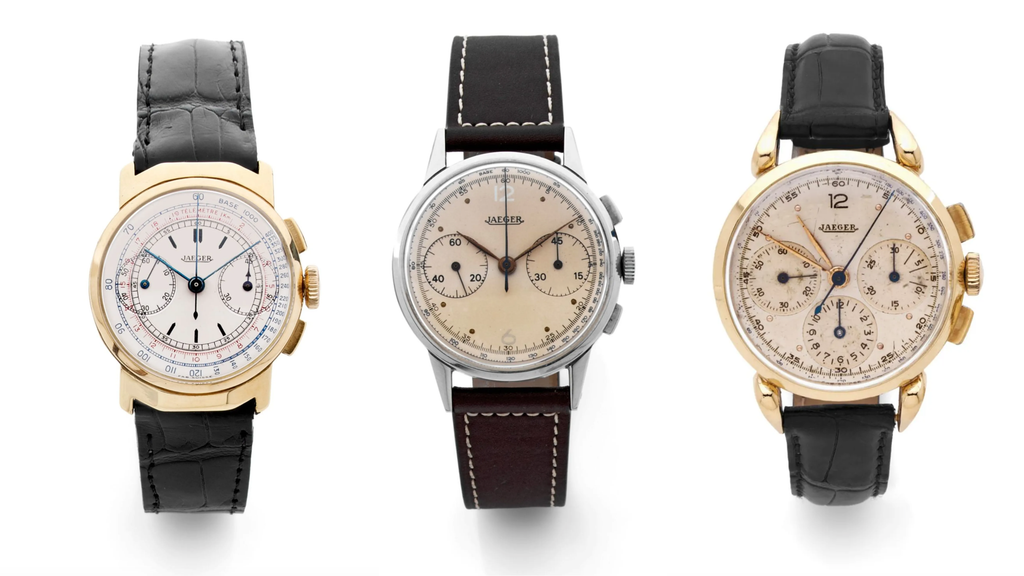 A small selection of chronograph variety offered by Jaeger(-LeCoultre) during the last Century. Photos Courtesy of Artcurial.
A small selection of chronograph variety offered by Jaeger(-LeCoultre) during the last Century. Photos Courtesy of Artcurial.
Regarding vintage Universal Geneve powered LeCoultre/Jaeger chronographs the challenges are multi-faceted. With Valjoux the open questions mainly regarded a missing reference number system and thus an uncertainty of what ultimately existed in the catalogues... That is completely different on the UG side of things but nonetheless several aspects make it hard to comprehend this collecting niche to the fullest:
1) Vast number of references - and thus configurations
2) Rarity particularly on the LeCoultre (U.S.) side of the Atlantic
3) Basically close to white-label production
But before we get ahead of ourselves let's start from the beginning.
1) Recap - Two Types of Movements
All the LeCoultre signed chronograph watches featured one of two movement families: Valjoux or Universal Geneve. I approached the Valjoux pieces in Part I and will now focus on Universal Geneve for Part II. Gladly, the two caliber families are well distinguishable even without opening the case-back. Jaeger & LeCoultre made it easy for us and designed very distinct watch cases according to the movement ticking inside:
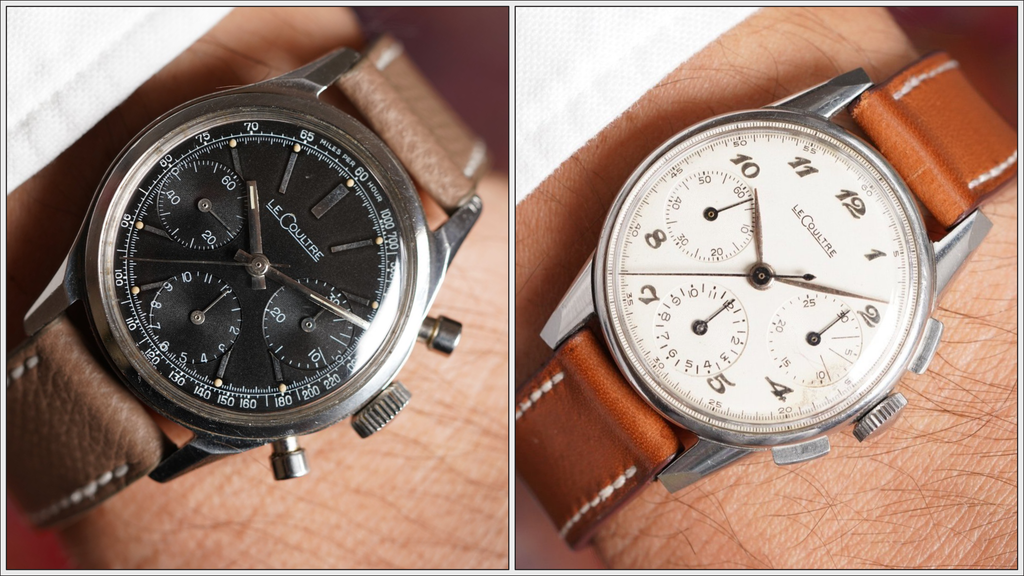 Two LeCoultre chronograph pieces, the left (ref. 2644) with a Valjoux 72 and the right (ref. 224115) with a Martel/UG 285. Photos Courtesy of WindVintage and Strictly Vintage Watches.
Two LeCoultre chronograph pieces, the left (ref. 2644) with a Valjoux 72 and the right (ref. 224115) with a Martel/UG 285. Photos Courtesy of WindVintage and Strictly Vintage Watches.
On the one hand, all pieces with a Valjoux movement come with mushroom chronograph pushers and screw-down case-backs. On the other hand, Universal Geneve (Martel) powered LeCoultre chronographs feature rectangular pushers and a snap-on case-back[2]. Thank you Jaeger-LeCoultre for sticking to thisx!
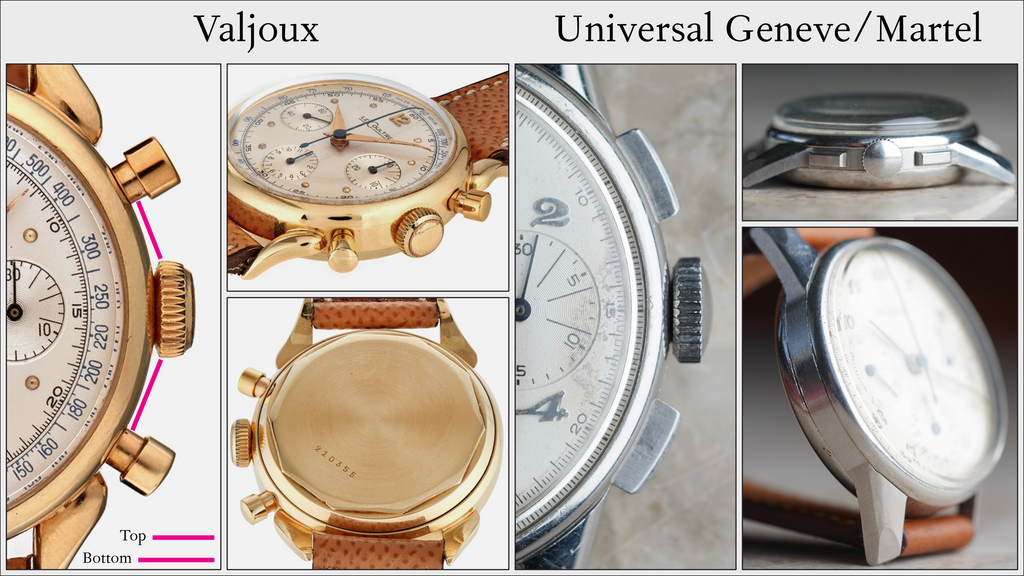 Figure 1. Comparing the distinct features of a Valjoux-(left) and UG/Martel-powered LeCoultre chronograph. UG/Martel come with rectangular pushers and snap-on case-backs. Valjoux examples always feature mushroom pushers and a screw-down case-back. By the way, you can always identify such a Valjoux-based chronograph independent of the manufacturer via the distances of the pushers from the crown: The top pusher is closer to the crown. Photos Courtesy of Hodinkee and Strictly Vintage Watches.
Figure 1. Comparing the distinct features of a Valjoux-(left) and UG/Martel-powered LeCoultre chronograph. UG/Martel come with rectangular pushers and snap-on case-backs. Valjoux examples always feature mushroom pushers and a screw-down case-back. By the way, you can always identify such a Valjoux-based chronograph independent of the manufacturer via the distances of the pushers from the crown: The top pusher is closer to the crown. Photos Courtesy of Hodinkee and Strictly Vintage Watches.
2) Piggybacking Universal Geneve's Structures
Valjoux-based chronographs were designs making good use of the etablissage structure of the Swiss watchmaking industry - they were assembled from parts of various sources. UG-based chronos on the other hand relied on a completely different strategy: The all-inclusive service package. This means that Universal Geneve - the Genevan chronograph powerhouse - provided every aspect of the watch (movement, case, everything) except the name on the dial.
From a modern perspective this is close to unthinkable but it was a standard practice during the 20th Century. Manufacturers could expand their catalogue, save on R&D and still provide the best quality for their customers as the parts/movements/watches sold under their name came from the best in their respective sector. So you will for example find such white-label-ish Girard Perregaux and Zenith chronograph pieces from the same era as well.
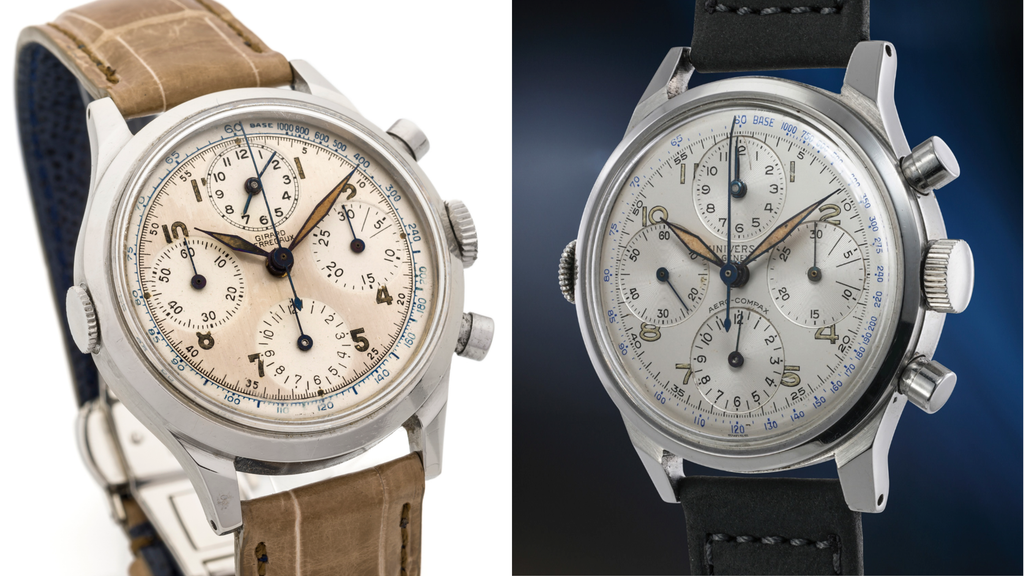 Comparing the Girard Perregaux and Universal Geneve Aero-Compax ref. 22432 with Spillman case. Photos Courtesy of Antiquorum & Phillips.
Comparing the Girard Perregaux and Universal Geneve Aero-Compax ref. 22432 with Spillman case. Photos Courtesy of Antiquorum & Phillips.
3) "Enversteel" & Universal Geneve associated case makers
A particularly interesting facet of the Universal Geneve production at the time was the use of the so-called Enversteel. It is an early stainless steel-alloy that was also competing with "Staybrite"[2]. On the other end of the case material spectrum we do also see that many of the gold cases were made by UG associated case makers: For example Jung & Fils (hallmark #128) and rarer Favre & Perret (#115) or Spillman (#136). However, I cannot really judge on pre-WWII production.
Combining all these aspects is why I speak of the Universal Geneve Jaeger/LeCoultre chronographs as "white label" production*.
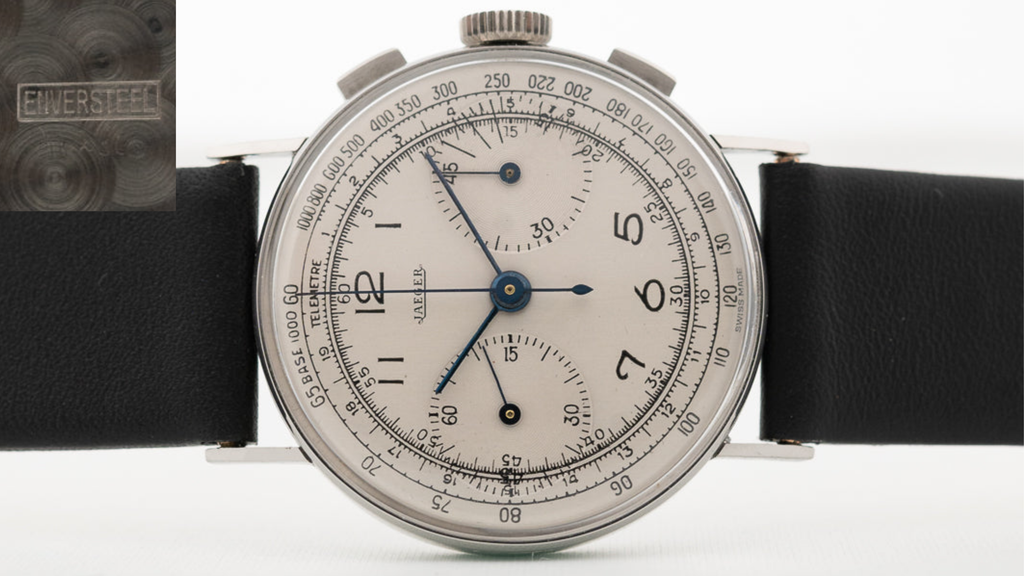 A 1950s Jaeger chronograph with "Enversteel" case - the same steel-alloy exclusively used for Universal Geneve chronograph designs. Photo from Goldammer Archives.
A 1950s Jaeger chronograph with "Enversteel" case - the same steel-alloy exclusively used for Universal Geneve chronograph designs. Photo from Goldammer Archives.
4) Reference Numbers
Well, here Jaeger and LeCoultre example further borrow from the Universal Geneve catalogue. This means most pieces come with the classic UG 5-digit referencing system**... applied on several dozens of different references and designs!
The referencing system goes as follows[2-3]:
- 1st digit for the material (1=18k; 2=steel; 3=chrome; 4=gold plated; 5=14k YG; 6=14k WG; 7=platinum)
- 2nd digit for the complication (2=chronograph)
- 3rd digit for chrono-movement (1=289; 2=281/283/481; 3=281/283/481/483; 4=285/385/386; 5=285/287/292/387)
- 4th-5th digit for case style***
 Figure 2. Two Example Vintage Jaeger chronograph watches to illustrate the UG reference number system. Left: Ref. 12566 (18k gold, chronograph, cal. 285, style 66) and Right: Ref. 22447 (steel, chronograph, cal. 285, style 47). Photos from Goldammer Archives.
Figure 2. Two Example Vintage Jaeger chronograph watches to illustrate the UG reference number system. Left: Ref. 12566 (18k gold, chronograph, cal. 285, style 66) and Right: Ref. 22447 (steel, chronograph, cal. 285, style 47). Photos from Goldammer Archives.
The 5-digit system was in place between the late 1930s and early 1960s. Prior to ~1938 UG used the 4-digit system but this early coding is relatively un-systematic. It appears numbers have been assigned without deeper meaning of material, movement and such[3]. Further, you rarely if ever encounter LeCoultre/Jaeger UG chronographs from the 1960s - these would otherwise sport 6-digit reference numbers[3]. This is likely because Zenith bought Universal Geneve/Martel in the late 1950s and potentially stopped selling their movements to competitors[5].
5) The References - A bunch of them
As I've mentioned before it is quite possible that dozens even hundreds of different UG-style references for both Jaeger and LeCoultre chronograph watches exist. It is hard to know for a fact but - based on available information and the recent market - it also seems that the latter ones are a lot scarcer. It appears thus pivotal to set some rules how to identify genuine pieces. In a first step I would thus like to showcase several references.
As a somewhat ground-truth for UG-style chronographs - even for white-label-ish examples - we can consult the Universal Geneve archives:
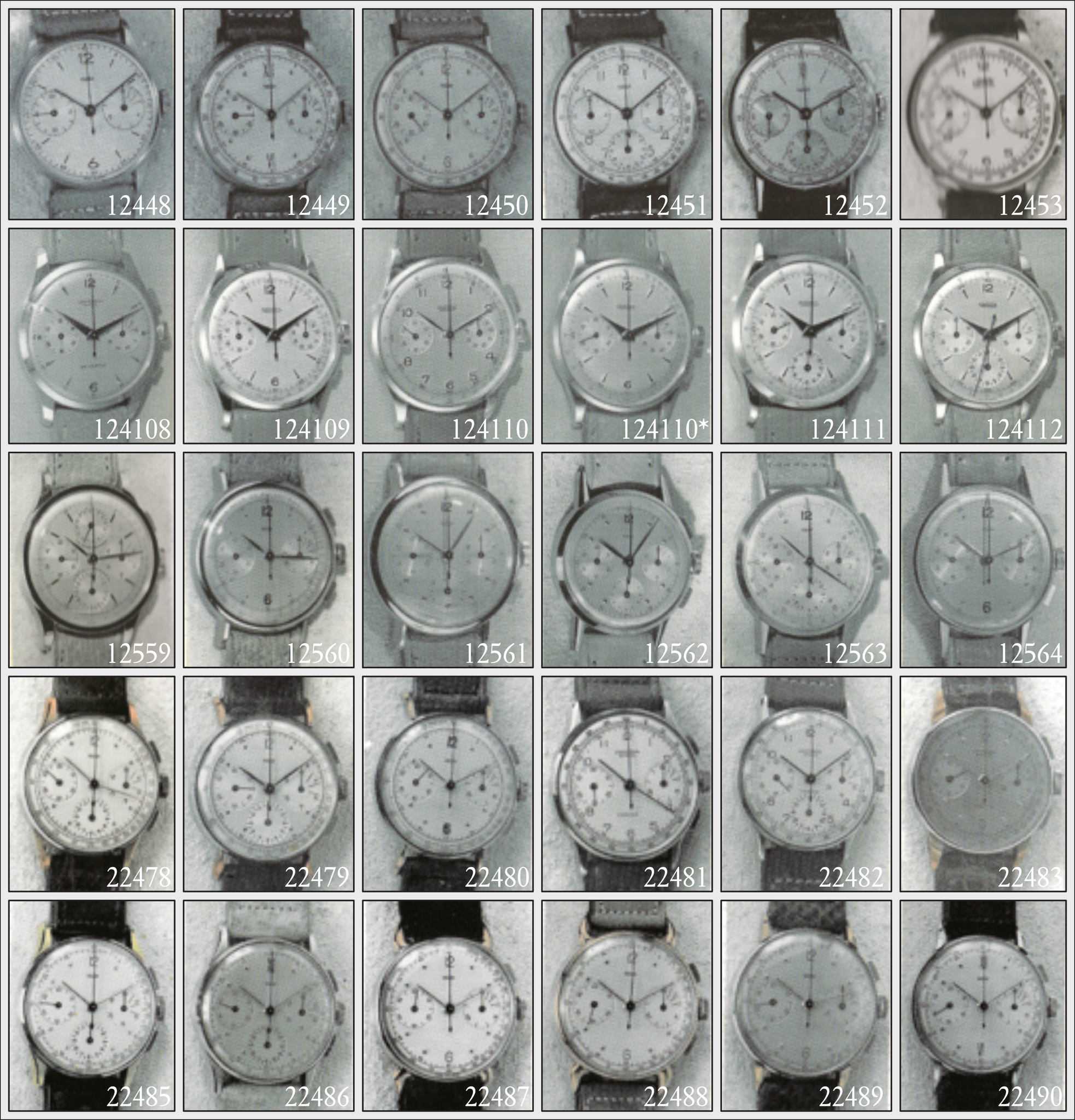 Figure 3. A large selection of Universal Geneve Jaeger-signed chronograph watches from the mid-20th Century. Photo Courtesy of Pietro Giuliano Sala's "Universal Geneve Watch".
Figure 3. A large selection of Universal Geneve Jaeger-signed chronograph watches from the mid-20th Century. Photo Courtesy of Pietro Giuliano Sala's "Universal Geneve Watch".
A second line of ground-truth appearance can be drawn from contemporary advertorials and catalogues. A bunch of those can for example be found in the vintage Jaeger-LeCoultre themed Artcurial auction catalogue (2011):
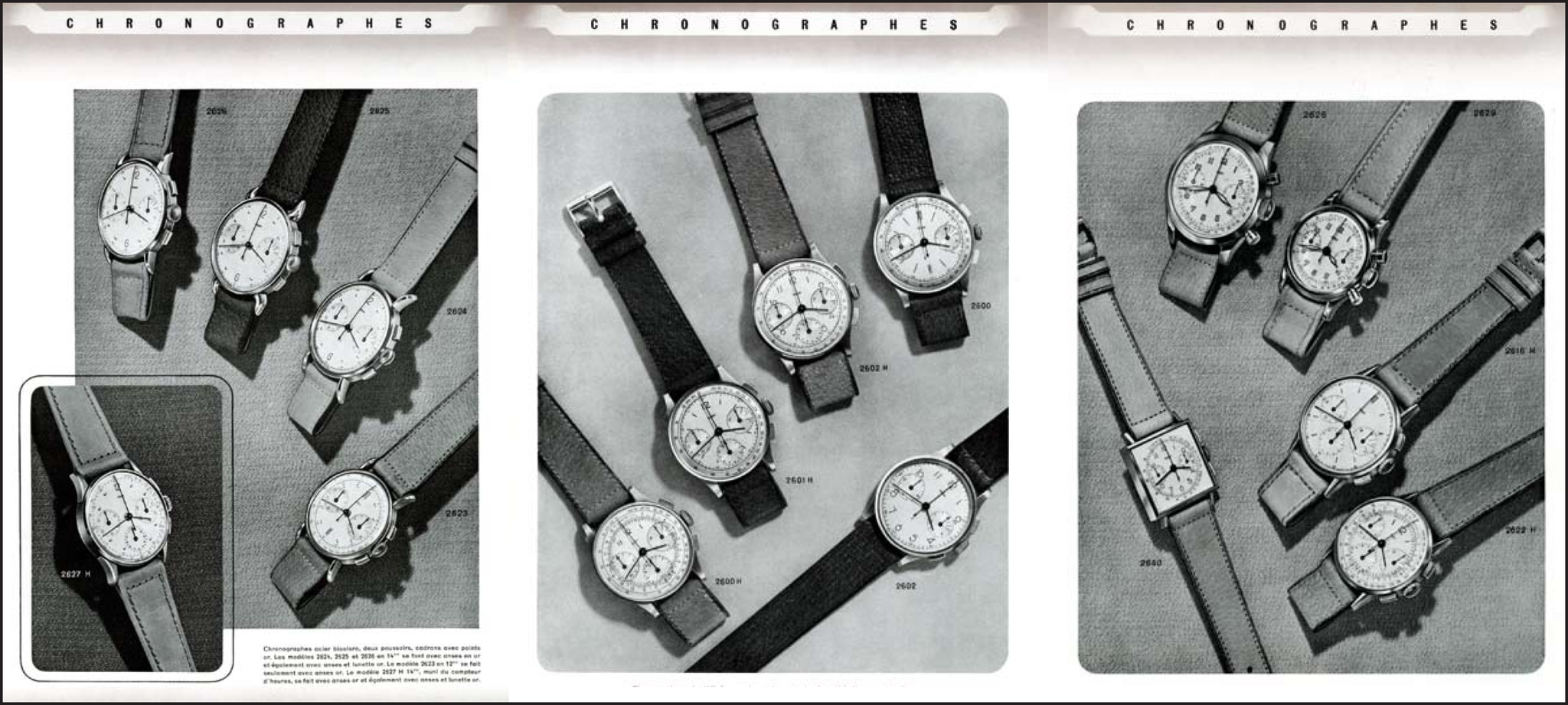 A mid-20th Century Jaeger "Chronographes" catalogue and advertorial highlighting several models from the time and including both Valjoux (round-pusher) and Universal Geneve (rectangular pusher) powered examples. Photo Courtesy of Artcurial.
A mid-20th Century Jaeger "Chronographes" catalogue and advertorial highlighting several models from the time and including both Valjoux (round-pusher) and Universal Geneve (rectangular pusher) powered examples. Photo Courtesy of Artcurial.
And lastly, back in 2011 Artcurial Paris held the "Jaeger-LeCoultre Unique Auction" sale with over 500 lots dedicated to the Swiss watchmaker. This is not ground-truth evidence yet the sale depicted some of the more exotic references that you might otherwise rarely come across:
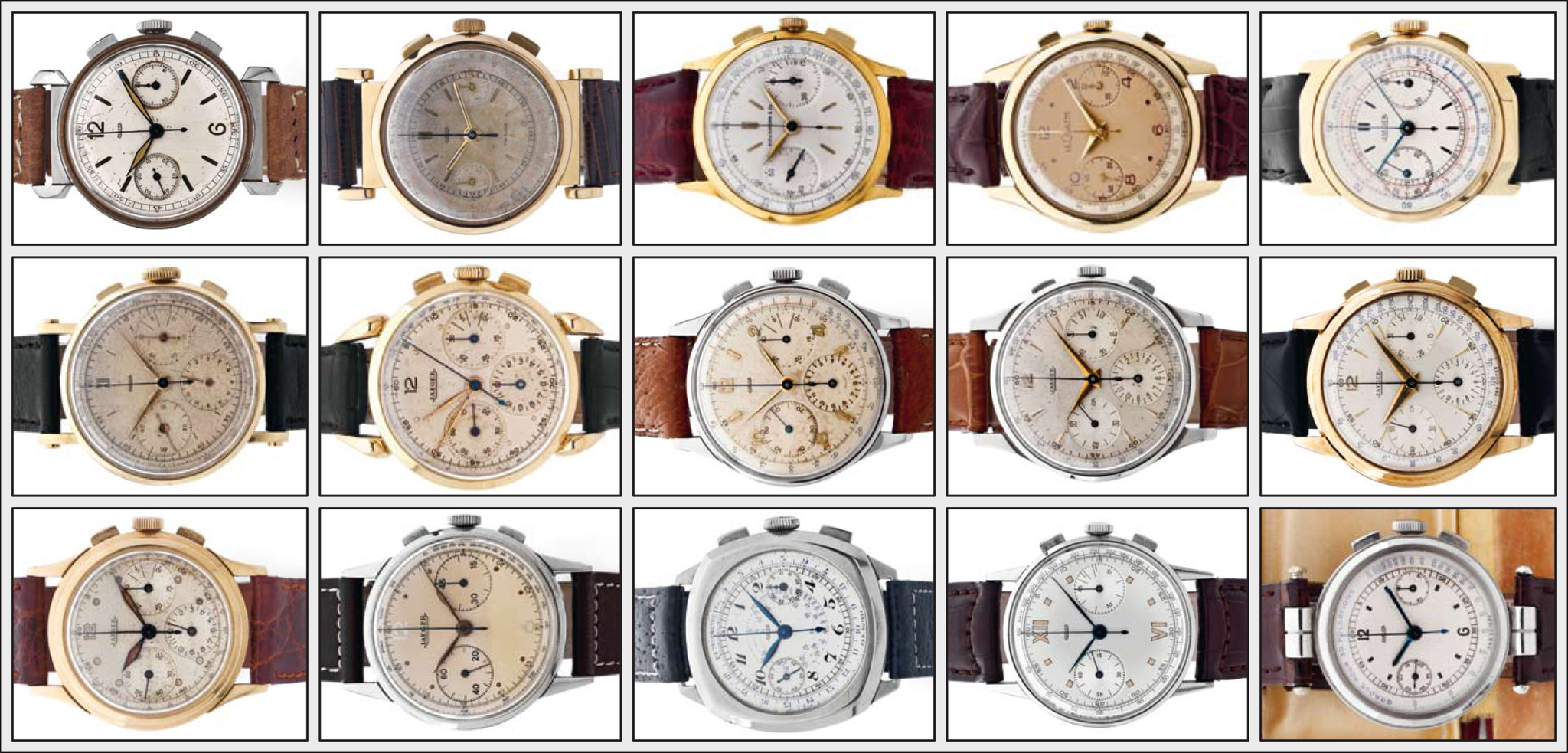 Jaeger and LeCoultre vintage chronograph watches offered at the 2011 "Jaeger-LeCoultre Unique Auction" themed Artcurial sale. Photos Courtesy of Artcurial.
Jaeger and LeCoultre vintage chronograph watches offered at the 2011 "Jaeger-LeCoultre Unique Auction" themed Artcurial sale. Photos Courtesy of Artcurial.
5*) Jaeger Internal Referencing System
The Universal Geneve coding is what you will find on the cases of these chronographs - yet this is not how they were always stored within the Jaeger/LeCoultre archives. If we look through the catalogues we will find the typical 4-digit system that applied to other non-chronograph watches as well. This coding didn't make it to caseback engravings until the 1960s - for example on Valjoux chronos - when UG-based chronographs were basically void from the catalogues already...
But for completeness let's add them here as well. The chronographs from that era fall in the 26xx reference range. Each internal reference corresponded to one particular case-style. However, each reference could come with 2-registers (base) or 3-registers (denoted "H"), in either 18k yellow gold or steel, and feature different movement sizes from 10''' (ligne) to 12''' and 14'''. Thus, for example a 2601H 14''' would be a calatrava style case with a 14 ligne (for example cal. 285) movement and additional 12h counter at 6o'clock (H).
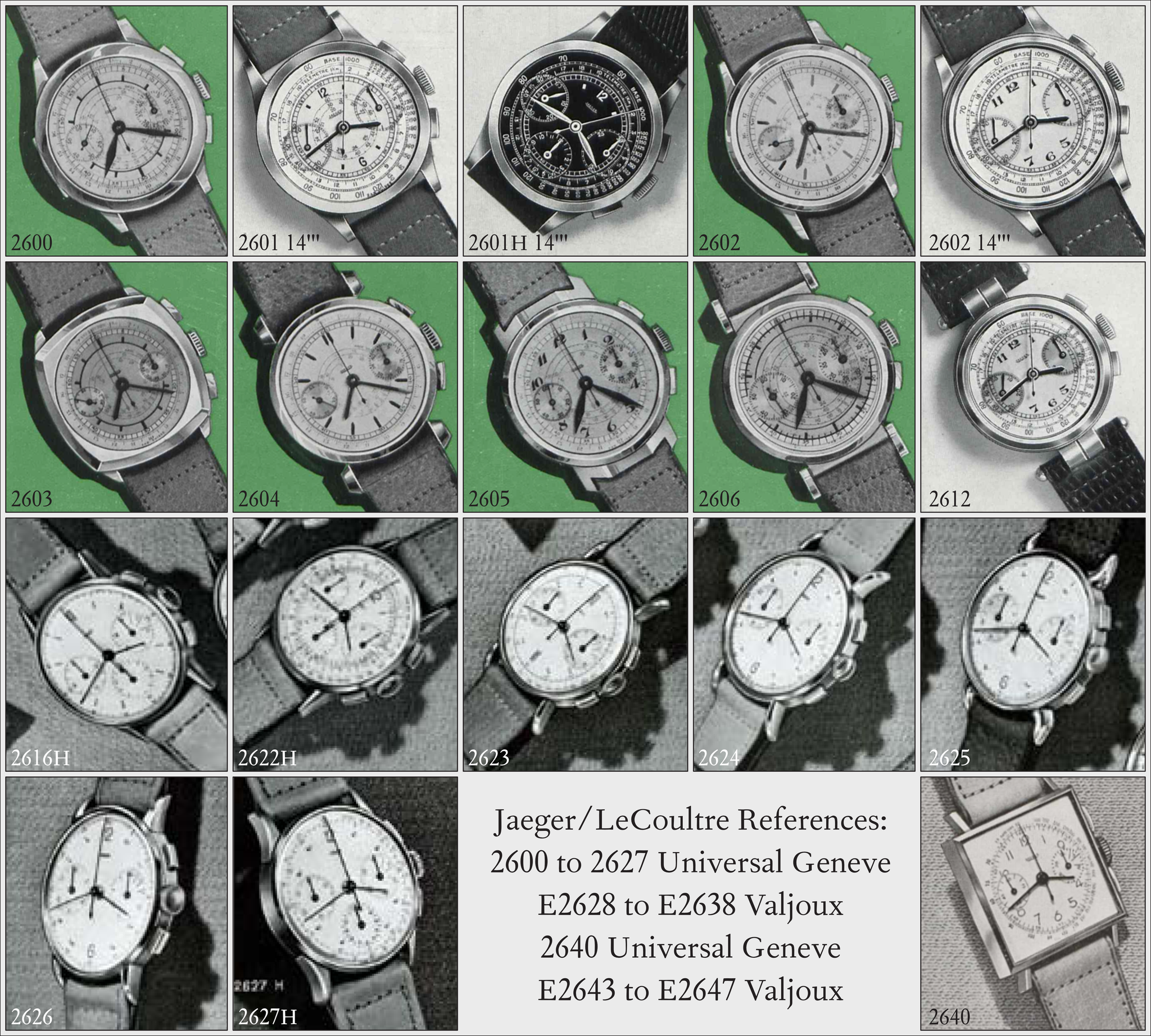 Figure 4. Jaeger/LeCoultre chronograph examples with the internal reference system for Universal Geneve based chronographs. Photos Courtesy of Artcurial and Jaeger-LeCoultre collector Clavi (@fldx_clavi).
Figure 4. Jaeger/LeCoultre chronograph examples with the internal reference system for Universal Geneve based chronographs. Photos Courtesy of Artcurial and Jaeger-LeCoultre collector Clavi (@fldx_clavi).
Within this reference system we can identify at least 29 distinct case styles - from 2600 to 2627 as well as the square 2640. The references E2628, E2629 and E2638 are established Valjoux powered chronographs, highlighting this as the probable range for some of the earlier Valjoux-powered Jaeger chronographs.
6) Dial Variations
We do find of course tons of different designs but certain features still stick out. First, as Universal Geneve calibers do not discriminate between with or without 12h-hour timer, we can find the same case style for neighboring references (For example 12450 (two-register) & 12451 (three-register)). Second, case styles appear to be not interchangeable between materials. For example a ref. 12447 is not simply the 18k golden version of the steel ref. 22447. And third, there appear to be only a handful of distinct variations for hands, markers and numerals:
Hands: Feuille or Leaf - Baton - Sword - Alpha - Dauphine -
Numerals: No Numerals - 12 Artdeco/Roman - 6-12 Arabic/Roman - Full Arabic/Breguet -
Markers: Dagger - Dots Applied - Prism Painted/Applied/Sandwich - Baton -
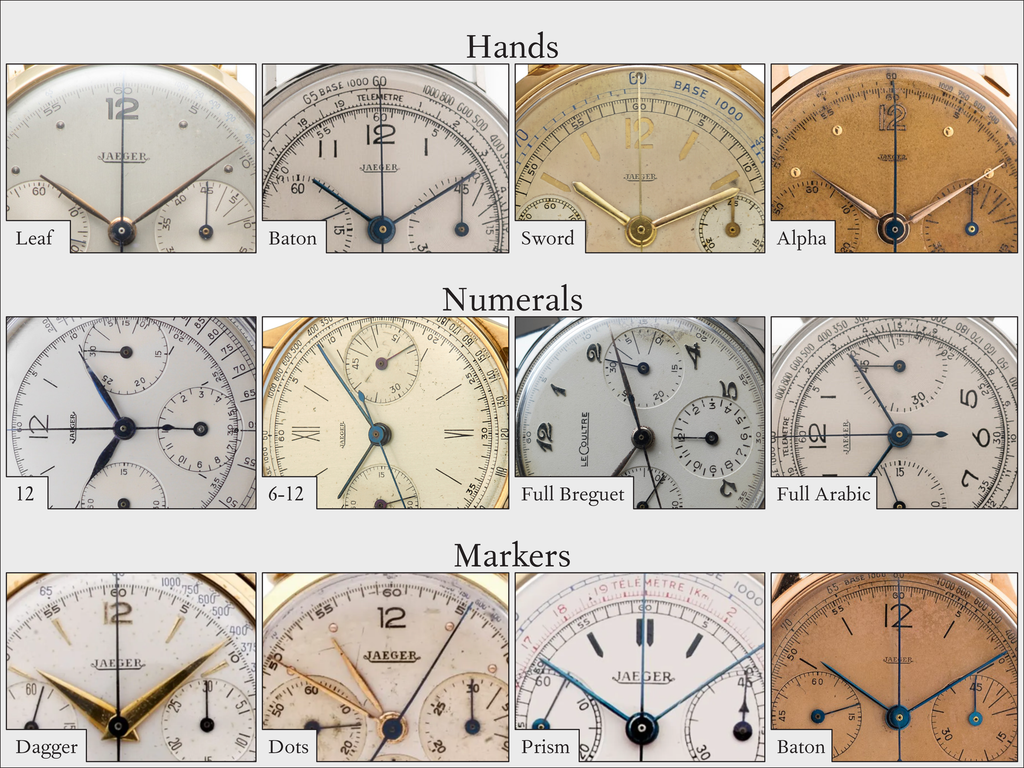 Figure 5. Example dial configurations on vintage Jaeger and LeCoultre chronographs (UG-based movements). Photos Courtesy of Antiquorum, Artcurial, SabiWatches, & Goldammer Archives.
Figure 5. Example dial configurations on vintage Jaeger and LeCoultre chronographs (UG-based movements). Photos Courtesy of Antiquorum, Artcurial, SabiWatches, & Goldammer Archives.
7) Collecting Caveats
I maneuvered us through some of the caveats of the vintage LeCoultre/Jaeger chronograph history but to make it a worthwhile collecting experience I further tried to come up with some features to better assess these pieces. However, bear in mind that these are simple heuristics and no strict rules. In the world of vintage watches there will likely be an exception to every rule if you dig deep enough!
a) The 5-digit reference system... The good thing is that you won't have to remember each and every reference. You'd only have to look out for the second digit as it should be a "2" (for chronograph) in almost every case. This is making good use of UG's system that was used between the late 1930s and early 1960s[3] in which most of the chronographs you'll encounter will fall. Further, due to Zenith buying Martel/UG in 1959[5] you probably won't find LeCoultre/Jager-UG chronos with a (true) 6-digit reference number.
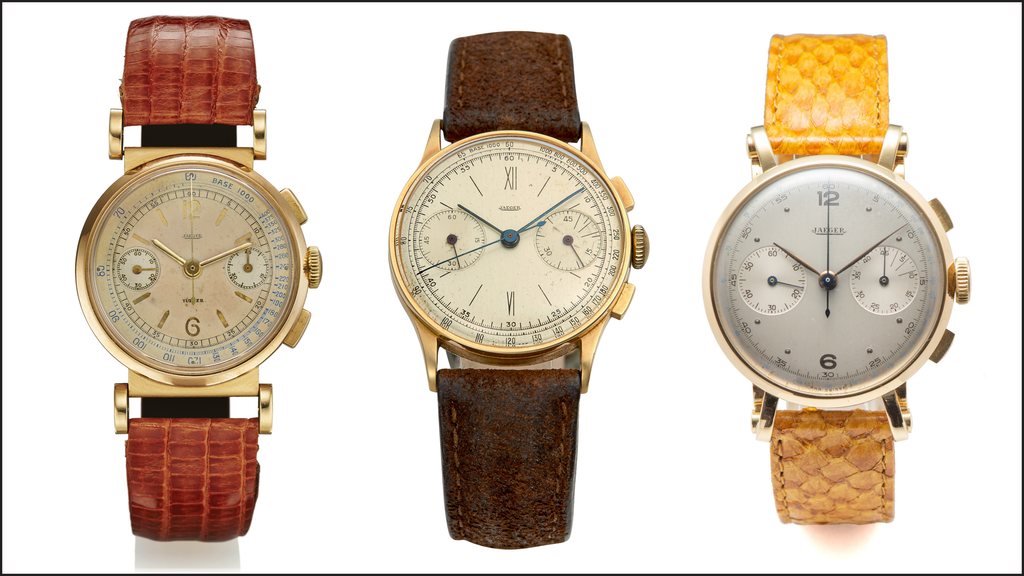 Three example Jaeger chronograph timepieces with Universal Geneve movement. The 6-12 numerals dial layout is quite a classic but the case constructions can vary from understated to full out flamboyant. Photos Courtesy of Antiquorum.
Three example Jaeger chronograph timepieces with Universal Geneve movement. The 6-12 numerals dial layout is quite a classic but the case constructions can vary from understated to full out flamboyant. Photos Courtesy of Antiquorum.
b) Numeral layouts... This is somewhat of a rule of thumb but given the appearances on the market I would argue that original dials feature either full numerals, no numerals or a 6-12 layout (12-only for "Heures" references with 12h counter). The dials I've encountered with "even" numeral layouts (2-4-6-etc.) were mostly reprinted. However, that doesn't mean that a given even-numbered dial can't be genuine as this is more of a heuristic from probability.
c) Jaeger-specific bridge... We can further perceive a small detail in the movement finishing or we might even call it a slight modulation. The bridge that typically carries the watchmakers signature on the movement has a very distinctive shape for Jaeger chronos, one that also differs from what Universal Geneve uses. As this is not a sign genuine or not it can still be used as a red flag in the evaluation of a given watch.
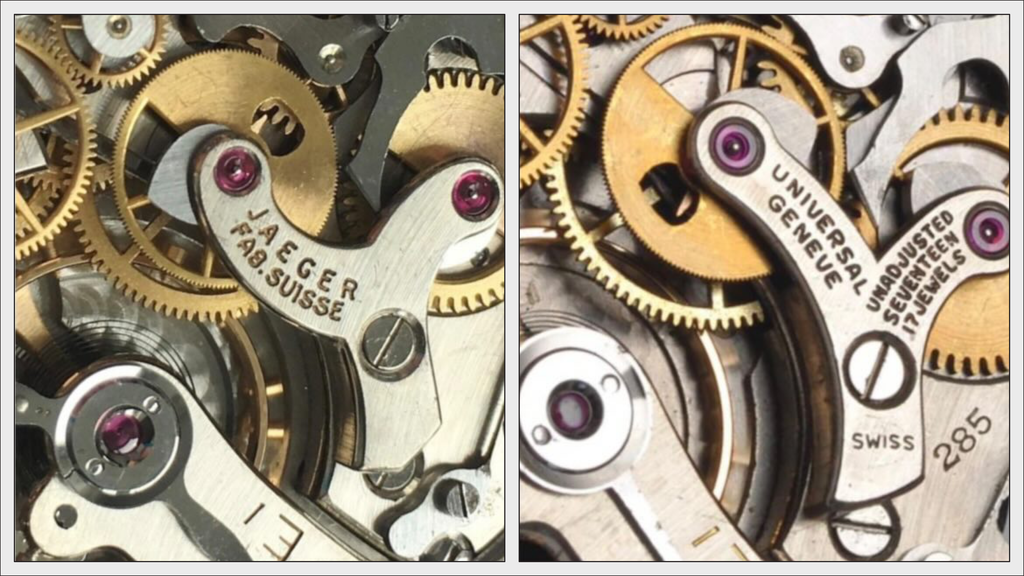 Comparing the movement bridges on a Jaeger and a Universal Geneve chronograph both with cal. 285. Photo Courtesy of Herman (@hurmen).
Comparing the movement bridges on a Jaeger and a Universal Geneve chronograph both with cal. 285. Photo Courtesy of Herman (@hurmen).
d) Fab. Suisse Jaeger... Made in Switzerland and for the French market. This is what a "Fab. Suisse" signed dial might indicate and what the Jaeger branch was intended for. You will often also find that not only Jaeger dials but also the movement or the caseback is signed "Fab. Suisse". However, Jaeger was still sold to several markets and not only France. At least Italy and some retailers overseas in the U.S. sold Jaeger signed timepieces as well. A lack of the "Fab. Suisse" signature is thus not necessarily a show-stopper.
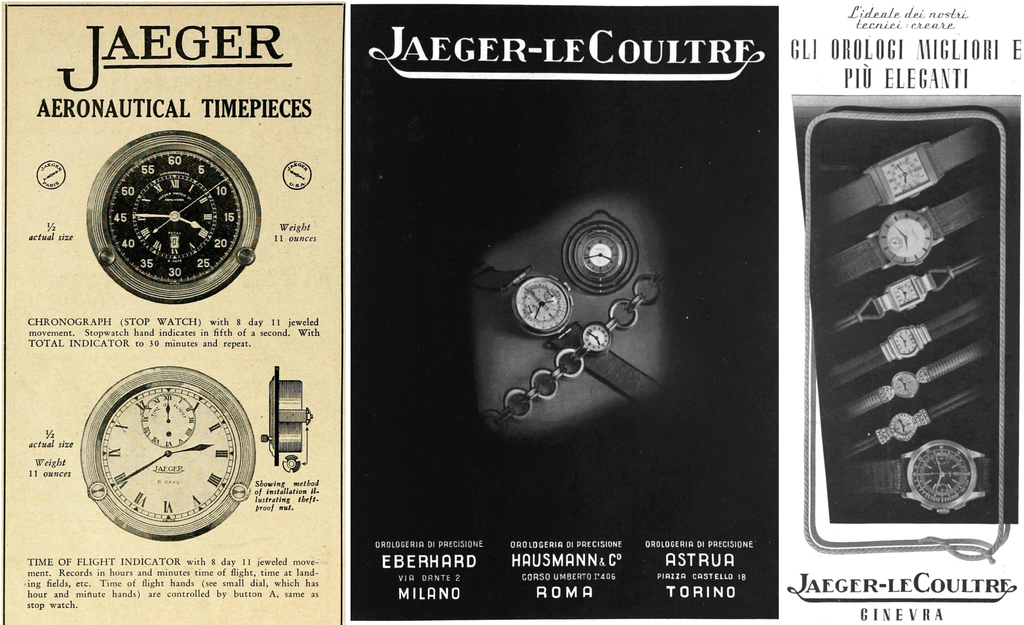 Three vintage watch advertorials from the 1940s and 1950s featuring Jaeger timepieces in markets outside of France and Switzerland. Left: U.S. American advertorial for Jaeger Aeronautical instruments (dials are signed "Swiss"); Middle/Right: Italian advertorials featuring Jaeger chronograph watches among the set of Jaeger-LeCoultre pieces. Photos Courtesy of HIFI Archiv.
Three vintage watch advertorials from the 1940s and 1950s featuring Jaeger timepieces in markets outside of France and Switzerland. Left: U.S. American advertorial for Jaeger Aeronautical instruments (dials are signed "Swiss"); Middle/Right: Italian advertorials featuring Jaeger chronograph watches among the set of Jaeger-LeCoultre pieces. Photos Courtesy of HIFI Archiv.
e) Rectangular Valjoux pusher... As it appears the general rule about the pusher distinction - rectangular for UG & pump for Valjoux - only in the strictest sense applies to LeCoultre chronographs. Jaeger Valjoux chronograph pieces (for example ref. 2634 & 2635) can display rectangular pushers as well, which is also underlined by original catalogue notes:
 Vintage Jaeger LeCoultre catalogue excerpt displaying two chronograph pieces with Valjoux movements (see the pusher distances to the crown) and rectangular pushers. On the left is the ref. 2634H (35mm) and on the left ref. 2635 (37mm). Photo Courtesy of vintage Universal Geneve collector Matt (@id3ologist).
Vintage Jaeger LeCoultre catalogue excerpt displaying two chronograph pieces with Valjoux movements (see the pusher distances to the crown) and rectangular pushers. On the left is the ref. 2634H (35mm) and on the left ref. 2635 (37mm). Photo Courtesy of vintage Universal Geneve collector Matt (@id3ologist).
8) Conclusion & Comparison to Valjoux
To me the fun in vintage Jaeger-LeCoultre chronographs comes from the fact that these are only partially Jaeger-LeCoultre. The Vallee de Joux based maison that was responsible for so many envied calibers and innovations didn't invest in the chronograph complication for most of their own history! That they still put their name (or at least parts of it...) on ebauche movements tells me one thing: Universal Geneve and Valjoux chronograph movements were among the best of the best in terms of precision timekeeping.
There further might be some regional market differences in the occurrence of both manufacturers. As the vintage watch market presented itself over the last couple of years it seems that Jaeger (French market) were predominantly UG-powered and LeCoultre (U.S. market) leaning more towards Valjoux. However, that is the market as of right now. If that would indeed translate to historical production numbers and ultimately sales is very hard to say.
Now but why use two different movement manufacturers in the first place? This is non-trivial as there is a lot of temporal overlap between both ebauche types. Why didn't Jaeger-LeCoultre just stick with what they might have considered the potentially superior movement? The answer might be because both offered very different opportunities.
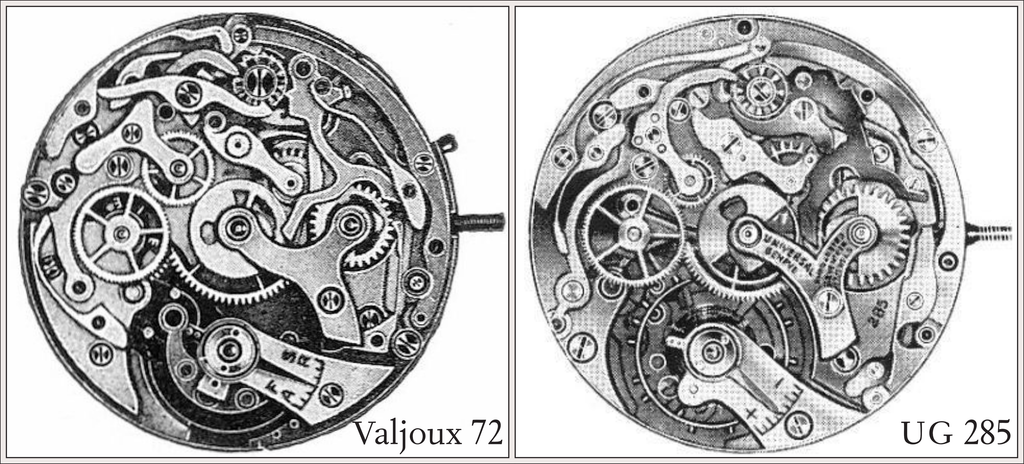 Comparing both movement types directly next to each other - the Valjoux 72 (left) and the Universal Geneve cal. 285 (right). Photos Courtesy of OldSwissWatches & GrailWatches.
Comparing both movement types directly next to each other - the Valjoux 72 (left) and the Universal Geneve cal. 285 (right). Photos Courtesy of OldSwissWatches & GrailWatches.
Consider this: Universal Geneve provided the all-inclusive package. They themselves produced fully assembled watches at a high quality with spearheading innovations at the time. It is the easiest and most convenient way if you want to get your name on a chronograph dial.
On the other hand, the Reymond brothers of Valjoux only produced movements[4]. As both manufacturers used column-wheel technology the movements were on par. But two advantages come to mind with the Valjoux partnership. First, regional proximity - you can drive 60km to Geneva (UG) or you just cycle the 3km to Le Bioux (Valjoux) to meet, interact and discuss new contracts. There is convenience in this close proximity relationship, too. Second, providing only the movement opens the possibility to have a stronger word in the design process. And I'd argue that's definitely what we see happened with JLC. The case designs they came up with for their Valjoux lineup has a lot of unique character! Thus, if you're into amazingly designed, well executed and unique case constructions you'd have to go with Valjoux. But it doesn't mean there is nothing special about the UG examples...
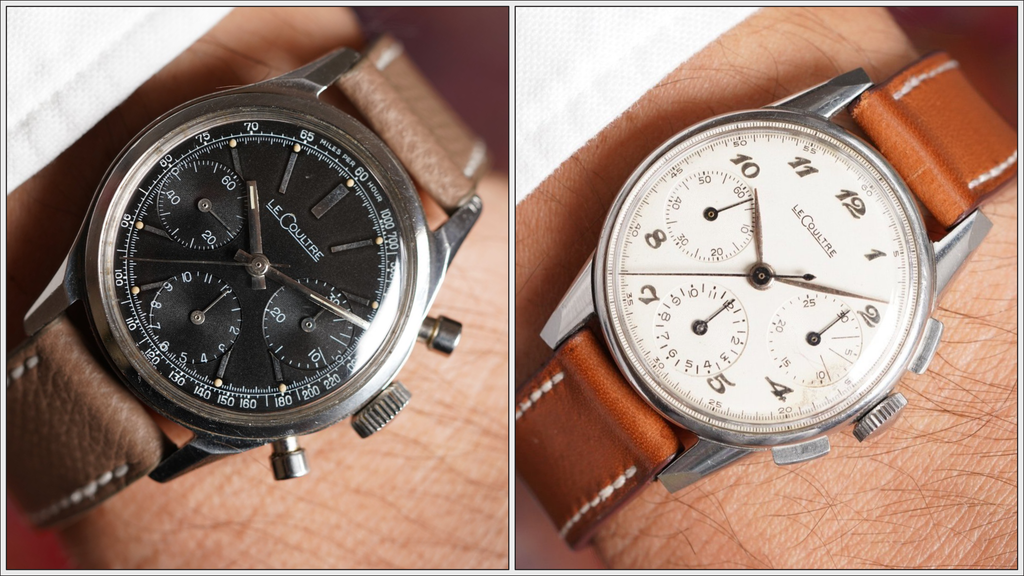 Comparing the Valjoux vs. the Universal Geneve powered LeCoultre/Jaeger chronographs there is no clear winner - To me it boils down to what you prefer: A standout and unique case design (Valjoux) or intricate dial execution (UG)? Photos Courtesy of WindVintage and Strictly Vintage Watches.
Comparing the Valjoux vs. the Universal Geneve powered LeCoultre/Jaeger chronographs there is no clear winner - To me it boils down to what you prefer: A standout and unique case design (Valjoux) or intricate dial execution (UG)? Photos Courtesy of WindVintage and Strictly Vintage Watches.
What I find Jaeger-LeCoultre did great on several of their Universal Geneve based chronographs - and potentially better - was the dial. Examples for example using beautifully applied Breguet numerals come to mind. But I'm particularly speaking about the so-called "Sandwich" dials. This is a two-level structure in which the markers (mostly prism) are sunk rather than raised due to cavities in the dial surface. These dials were mostly done by Stern Freres and add a depth to the dial that you will rarely find in any other dial construction!
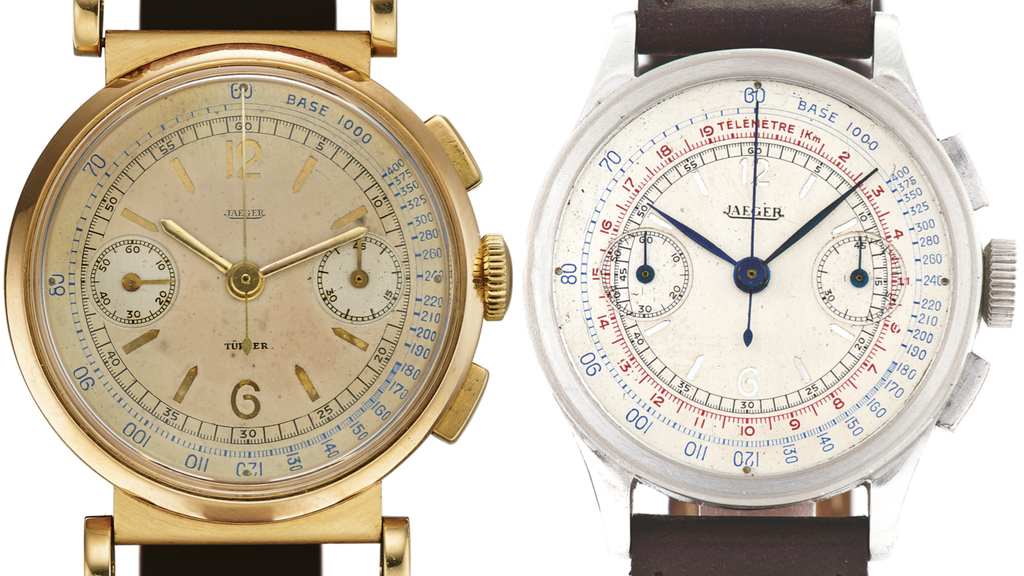 Two example Jaeger chronographs with Stern Freres "Sandwich" dials - a gold on white (left) and one white on silver (right). Photos Courtesy of Antiquorum.
Two example Jaeger chronographs with Stern Freres "Sandwich" dials - a gold on white (left) and one white on silver (right). Photos Courtesy of Antiquorum.
Thus, which caliber type you find more interesting or collectible might ultimately depend on what you favor more - cases or dials? Valjoux or Universal Geneve? Jaeger or LeCoultre? French flair or the American Dream? It's hard to decide right away but I can certainly loose my heart to both!
- These two guides wouldn't have been possible without the help from the JLC & UG community! This is very much a group effort I was lucky enough to write down. I'd like to thank in particular Clavi (@fldx_clavi), Charlie Dunne (@StrictlyVintageWatches), Herman (@hurmen), and Matt (@id3ologist) for their invaluable input to this project! -
x Of course there's an exception to every rule... The UG-powered ref. 224105 (sold for example here, here, here, here & here) appears to come with mushroom pushers and a screwdown case back (probably produced in at least three batches of a few dozen examples)... It's hard to brush all of these aside as Frankenpieces particularly as one of the offerings came with an extract from JLC. So it might indeed be possible that this was an exception to the case-to-movement rule. It is also a uncommonly oversized piece at 38mm, which I can speculate to have something to do with using a different case construction altogether.
* White-Label Production = A term that originates from the concept that a third-party is manufacturing a product for the company that is ultimately selling said product under their own name. Compatible examples can be found in retailer-branded watches for example from Tiffany, Guebelin or Cartier.
** Earlier examples feature the 4-digit reference system (prior to the 1940s)
*** As this referencing system only allows for 99 different styles (starts with "01") we can even in the 5-digit era find reference numbers with 6 digits as for example Charlie Dunne's/Max Braun's ref. 224115.
References
[1] The Jaeger-LeCoultre Reverso Chronographe Retrograde, The First In-House Integrated Chronograph Post-Quartz Crisis; Suhrud, Monochrome Watches [Link]
[2] LeCoultre Chronograph Reference 224115; Charlie Dunne, Strictly Vintage Watches [Link]
[3] Universal Geneve References; Mr. A, UniversalGeneve.Info [Link]
[4] The Reymond Brothers & Their Chronographs - A Guide to the Valjoux 23/72; Marcus Siems, Goldammer Vintage Watches [Link]
[5] A Short History Of Martel Watch Co and Zenith Chronographs; SemperVivens, WatchUSeek [Link]
All rights on text and graphics reserved to the Author.




























1 comment
I have waited for this article for years! I have a passion for JLC and have many books on the Grande Maison from Cologni to Zaf (Basha) and including the books from JLC themselves like the collectibles book. No one has documented in one place this level of scholarship. This is an absolute feat given the variation and ‘frankenwatches’ plus the lack of / inconsistent documentation from JLC themselves. Absolutely amazing work, I hope more see this and read it with the fascination that I did! I personally have eyes for a UG piece and hope to add one to the collection one day. Thank you Goldammer team, amazing amazing work!
Leave a comment